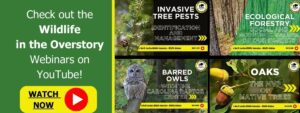Treetop Wildlife and Forest Habitats Face Threats from Invasive Species
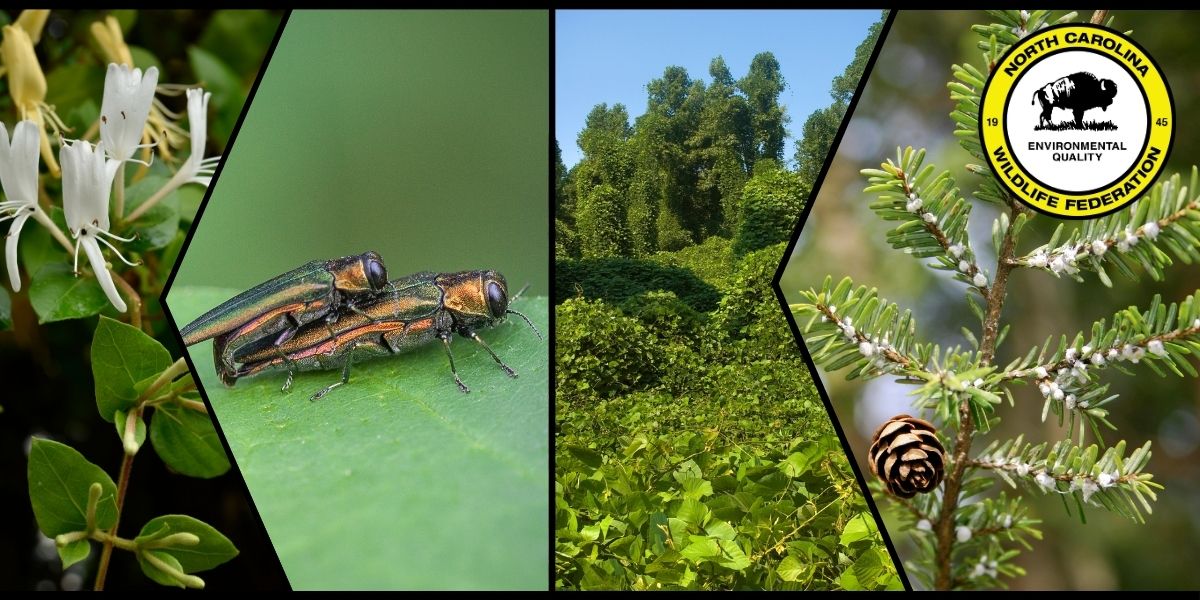
Nature operates in a delicate balance, where each species has a specialized role to play in its ecosystem. But this balance is threatened by many modern-day factors that have impacts on these ecosystems. Among these harmful factors are invasive plants and animals.
Invasive species, often introduced by human actions like trade and landscaping, do not merely damage and kill native species, they put pressure on the entire ecosystem they are introduced into, spreading rapidly and competing with native species for resources.
In April, 2024, NCWF highlighted Wildlife in the Overstory. While there is a multitude of wildlife species observable at ground level, many rely on the shelter and resources provided by trees, particularly those thriving in their canopies. These tree canopies can create an entirely distinct habitat for wildlife, many of which have evolved and adapted to depend upon trees. However, these habitats – and the wildlife within them – face increasing threats from deforestation and habitat fragmentation, much of which results from human development and changes in land use.
In this blog post, we discuss some of North Carolina’s invasive tree species, invasive pests that prey on native tree species, and other threats facing North Carolina’s trees and the wildlife services they provide.
Invasive Tree Species
Invasive tree species take up space and aggressively compete for resources needed by native trees and plants. By nature of adapting to the same climates and environmental circumstances as local wildlife, many native tree species serve as host plants for pollinators and other wildlife.
As introduced species spread at a rapid pace, invasive trees offer few services to wildlife and diminish opportunities for native plants to flourish. Here are a few invasive tree species that have taken hold across the state:
Bradford/Callery Pear (Pyrus calleryana)
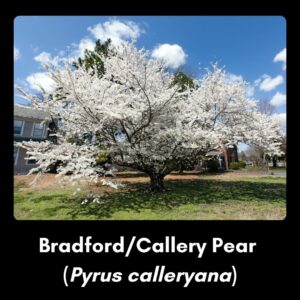 The Bradford pear is a moderate-sized, deciduous tree originating from China and Taiwan. Initially introduced into urban landscapes for its ornamental appeal, this species has since spread in the United States, encroaching upon natural habitats.
The Bradford pear is a moderate-sized, deciduous tree originating from China and Taiwan. Initially introduced into urban landscapes for its ornamental appeal, this species has since spread in the United States, encroaching upon natural habitats.
Bradford pear trees pose a risk to ecological balance by outcompeting native vegetation such as grasses, wildflowers, shrubs, and young trees. This, in turn, detrimentally affects local wildlife and crucial pollinators reliant on native plant species.
Characterized by glossy, dark green foliage and clustered, five-petaled flowers at the tree’s terminal points, Bradford pears emit an unpleasant, musky odor during springtime. Following pollination, these flowers give rise to large crops of fruit, aiding in the species’ spread. However, their brittle branches often do not hold up in inclement weather conditions, rendering them relatively short-lived and hazardous additions to landscapes.
Tree of Heaven (Ailanthus altissima)
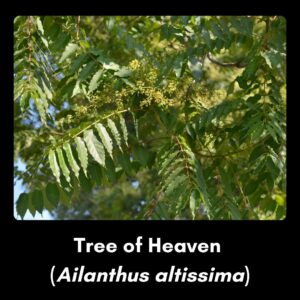 The tree of heaven, initially introduced as an ornamental for its rapid growth in various garden conditions, has now become an invasive species infiltrating natural habitats across numerous regions of the United States, including North Carolina. Regarded as a Rank 1 – Severe Threat invasive by the North Carolina Native Plant Society, its presence poses significant ecological concerns.
The tree of heaven, initially introduced as an ornamental for its rapid growth in various garden conditions, has now become an invasive species infiltrating natural habitats across numerous regions of the United States, including North Carolina. Regarded as a Rank 1 – Severe Threat invasive by the North Carolina Native Plant Society, its presence poses significant ecological concerns.
The tree of heaven forms dense thickets through its proliferating root suckers, disperses seeds by wind and water, and emits toxic compounds from its roots, hindering the growth of native plants.
Featuring large compound leaves with notched bases on each leaflet and serrations along the margins towards the leaf base, the tree of heaven produces abundant clusters of yellow flowers in spring, succeeded by winged fruits easily carried by wind and water currents.
Removing the tree of heaven demands consistent effort and ongoing commitment. Treated areas necessitate regular monitoring, with quick removal of new suckers or seedlings. Numerous native alternatives, such as hickories, green ash, butternut, smooth sumac, and staghorn sumac, are great choices for replacing these trees on your property.
Mimosa (Albizia julibrissin)
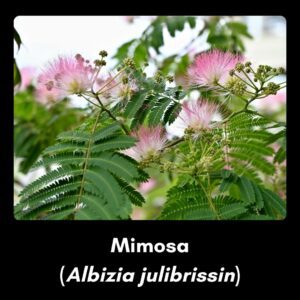 Introduced to the United States in the 1700s for its vibrant flowers, the mimosa tree has escaped its intended spaces, encroaching upon natural areas. Mimosa trees spread rapidly, forming dense thickets with their spreading roots, which generate new shoots. This extensive coverage, both above and below ground, effectively shades out native vegetation, commandeering riparian habitats, edge zones, and disturbed areas.
Introduced to the United States in the 1700s for its vibrant flowers, the mimosa tree has escaped its intended spaces, encroaching upon natural areas. Mimosa trees spread rapidly, forming dense thickets with their spreading roots, which generate new shoots. This extensive coverage, both above and below ground, effectively shades out native vegetation, commandeering riparian habitats, edge zones, and disturbed areas.
Featuring pink, feathery flowers during the summer months and fern-like leaves, the tree produces oblong seed pods from pollinated flowers. These pods are either dispersed by foraging wildlife or carried to new locations by wind or water currents.
When removing mimosas from your property, replace them with a native alternative such as red buckeye, serviceberry, false indigo, or eastern redbud.
Chinese Tallow Tree (Triadica sebifera)
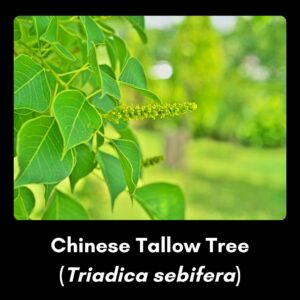 Chinese tallow, a drought-tolerant shade tree indigenous to China and Japan, found its way to South Carolina in the 1700s. Initially introduced as an ornamental landscaping feature and for the utility of its seed oils in soap making, it has established itself from eastern North Carolina southward to Florida, then westward through Louisiana, Arkansas, and into Texas.
Chinese tallow, a drought-tolerant shade tree indigenous to China and Japan, found its way to South Carolina in the 1700s. Initially introduced as an ornamental landscaping feature and for the utility of its seed oils in soap making, it has established itself from eastern North Carolina southward to Florida, then westward through Louisiana, Arkansas, and into Texas.
Characterized by yellowish flowers lacking petals, which emerge on eight-inch dangling spikes, the tree boasts leaves with elongated, pointed tips. The upper leaf exhibits a medium to dark green hue, while the underside appears lighter. Over time, the trunk may develop gnarled and fissured textures, with bark thickening as the tree matures, sometimes shedding in narrow, vertical strips.
While historically more prevalent in southern states like Louisiana and Florida, Chinese tallow numbers are increasingly noticeable in North Carolina. Its potential invasion of undisturbed forests poses a threat to native plant communities. Individual trees produce abundant seeds dispersed by birds, facilitating their spread to new locations.
Eradication efforts involve tree removal, with particular attention given to eliminating the popcorn-like seed clusters.
After removing Chinese tallow trees, replace them with red maple, flowering dogwood, or eastern redbud.
Invasive Tree Pests
In addition to invasive tree species, certain invasive wildlife species have caused critical damage to native trees and the wildlife that depend upon them.
Hemlock Wooly Adelgid (Adelges tsugae)
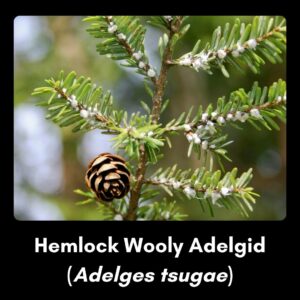 Hemlock wooly adelgids are aphid-like insects that often go unnoticed by the average outdoor recreationist, latching onto the needles of hemlock trees and feeding on their branches, preventing the flow of nutrients and causing the needles to weaken and fall off. After becoming infested, hemlock trees often die within a few years. This invasive pest originated in Asia and was discovered in the United States in the 1920s and later in the eastern states in the 1950s.
Hemlock wooly adelgids are aphid-like insects that often go unnoticed by the average outdoor recreationist, latching onto the needles of hemlock trees and feeding on their branches, preventing the flow of nutrients and causing the needles to weaken and fall off. After becoming infested, hemlock trees often die within a few years. This invasive pest originated in Asia and was discovered in the United States in the 1920s and later in the eastern states in the 1950s.
Hemlock wooly adelgids are already a widespread issue but have the potential to become an even larger one, with many scientists anticipating that it could mirror the chestnut blight that decimated the American chestnut in the early 20th century.
Emerald Ash Borer (Agrilus planipennis)
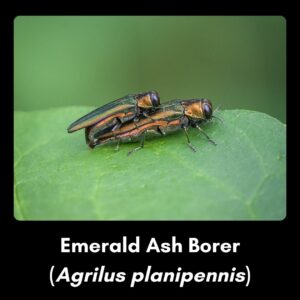 The emerald ash borer is a metallic green beetle that tunnels through the bark of ash trees to eat the inner tissues beneath the bark, ultimately killing the tree. It was first found in the midwest of the United States, having traveled overseas from Asia in wooden packing materials. As an invasive species, it has rapidly spread across the United States into North Carolina, leaving tens of millions of dead ash trees in its wake.
The emerald ash borer is a metallic green beetle that tunnels through the bark of ash trees to eat the inner tissues beneath the bark, ultimately killing the tree. It was first found in the midwest of the United States, having traveled overseas from Asia in wooden packing materials. As an invasive species, it has rapidly spread across the United States into North Carolina, leaving tens of millions of dead ash trees in its wake.
Emerald ash borers are a very difficult species to manage, as they are a widespread, flying insect species that can travel up to several miles each year. But perhaps more dangerous is their ability to hide unnoticed in wooden packing materials, subsequently being unintentionally spread by humans across states and even international borders.
Research to manage the beetle is ongoing and the best management plan for now is to minimize its spread while seeking a permanent solution.
Other Threats to Native Trees
Laurel Wilt Disease
Laurel wilt disease, caused by the fungus Raffaelea lauricola, poses a threat to several species of laurel trees, particularly the native redbay (Persea borbonia), a prominent feature of the North Carolina coast. First identified in the southeastern United States in the early 2000s, laurel wilt disease is primarily spread by the invasive redbay ambrosia beetle (Xyleborus glabratus), which carries the fungus as it infests healthy trees. Once introduced into a tree, the fungus spreads rapidly, obstructing water flow and causing wilting, leaf necrosis, and eventual tree death.
In addition to redbay trees, laurel wilt has devastating effects on other members of the laurel family, including sassafras (Sassafras albidum) and swamp bay (Persea palustris).
State instituted quarantine measures aim to prevent the spread of infected wood products and limit the movement of potentially infested plant material.
Kudzu (Pueraria)
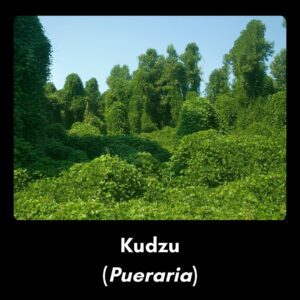 Among the notorious invasive plant species in North Carolina and throughout the southeastern United States is kudzu. Since its introduction from Asia, kudzu has aggressively taken over native habitats, utilizing both rhizomes and runners to overtake forest edges, open fields, and disturbed habitats. Its dense shade, vigorous growth, and substantial vines suffocate native vegetation.
Among the notorious invasive plant species in North Carolina and throughout the southeastern United States is kudzu. Since its introduction from Asia, kudzu has aggressively taken over native habitats, utilizing both rhizomes and runners to overtake forest edges, open fields, and disturbed habitats. Its dense shade, vigorous growth, and substantial vines suffocate native vegetation.
Kudzu produces purple spike flowers that dangle from its stems.
If there is kudzu on your property, it is best to remove it and replace it with native vines such as passionflower or crossvine. However, eliminating kudzu can be an intensive and laborious task. When using mechanical removal methods, meticulous attention must be paid to tracing the vine to its base and extracting the bulb-like structure known as a “crown” from the root system. In cases where kudzu is well-established and covers large areas of ground, multiple crowns may need to be removed.
Japanese Honeysuckle (Lonicera japonica)
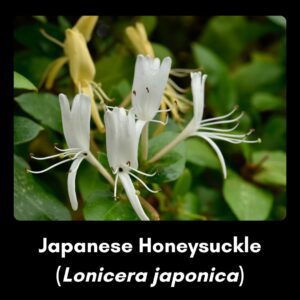 Japanese honeysuckle is an invasive plant that was originally introduced as an ornamental vine. It spreads aggressively by rhizomes and bird-dispersed seeds.
Japanese honeysuckle is an invasive plant that was originally introduced as an ornamental vine. It spreads aggressively by rhizomes and bird-dispersed seeds.
Forming dense mats, Japanese honeysuckle quickly overwhelms and shades out native vegetation and can constrict native tree trunks.
This plant can be identified by its fragrant flowers which blossom all summer long, and by black fruits that form in fall.
If you have Japanese honeysuckle in your yard, please remove it and replace it with the native coral honeysuckle or other flowering vines such as Carolina jessamine or crossvine.
A Note on Preventing the Spread of Invasive Species
It can be extraordinarily difficult and costly to control or eradicate invasive plants once they are established. The best approach to dealing with invasive plants is to prevent their spread in the first place.
- Learn to identify invasive plants. The Butterfly Highway Newsletter features a different invasive plant species each week and serves as a great starting point for distinguishing between native and invasive plants.
- Verify that plants you purchase for outdoor areas are native to North Carolina or are non-invasive exotic species that will not spread beyond control. Ask your local nursery staff for help and check out NCWF’s Native Plant Resources.
- Plant native plants. Having a diverse and robust population of native plants in your backyard reduces opportunities for invasive plants to take hold. Check out our list of statewide native plant nurseries!
- Don’t pick the flowers of noxious weeds to take home and don’t pick or transport flowers you can’t identify. Drive vehicles only on established roads and trails away from weed-infested areas.
- Clean outdoor recreation gear (hiking boots, fishing pole, waders, etc) after each use.
Want to learn more about invasive species and Wildlife in the Overstory?
Written by:

– Bates Whitaker, NCWF Communications & Marketing Manager
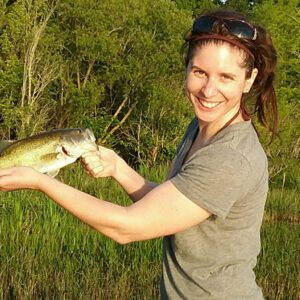
– Dr. Liz Rutledge, NCWF VP of Wildlife Resources


